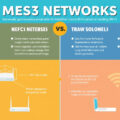In our increasingly interlinked society, "connectivity" emerges as a pivotal concept, shaping everything from personal relationships to global commerce. Defined by the Merriam-Webster Dictionary as "the quality, state, or capability of being connective or connected," connectivity underpins a multitude of systems and processes that facilitate communication and interaction in the digital age.
The Evolution of Connectivity
The term "connectivity" has gained significant traction since its first recorded use in 1893. Initially associated with physical and mechanical systems, the concept has expanded to encompass the digital realm, emphasizing the capability of devices to communicate with one another. From wired connections to Wi-Fi and endless digital interactions, the progression of connectivity symbolizes human innovation, fostering collaboration and creativity across varying platforms.
Digital Connectivity: A New Frontier
The digital age has magnified the importance of connectivity in everyday life. The integration of advanced technologies, such as the Internet of Things (IoT) and artificial intelligence (AI), has transformed not just how we connect, but also how we interact with our environments. For instance:
-
Internet of Things: Devices ranging from household appliances to industrial machines are equipped with sensors and internet connectivity, enabling them to communicate and share data. This continuous exchange results in smarter infrastructure and improved efficiencies, paving the way for smart cities and enhanced daily living experiences.
-
Remote Work and E-Learning: The global shift toward remote work and online education has highlighted the critical need for reliable internet access. Connectivity has become synonymous with productivity, allowing individuals to maintain personal and professional obligations irrespective of location.
Connectivity’s Impact on Society
Connectivity profoundly influences various sectors, including education, healthcare, and entertainment:

-
Education: The shift towards online learning has led to innovative educational platforms that enhance accessibility. Programs like the Federal Communications Commission’s (FCC) Affordable Connectivity Program, which previously offered subsidies for low-income households, exemplify efforts to bridge the digital divide and ensure that all students can access learning resources.
-
Healthcare: Telemedicine has surged as healthcare providers leverage connectivity to deliver services. Patients can consult with healthcare professionals from the comfort of their homes, improving health outcomes, particularly in underserved areas.
-
Commerce: Connectivity is central to e-commerce, enabling businesses to reach consumers globally. Online platforms benefit from the ease of communication and transaction processing, which has become essential for adapting to changing market dynamics.
Connectivity Challenges and Solutions
Despite its benefits, connectivity also presents challenges. Issues like inadequate infrastructure in rural areas and cybersecurity threats require attention. The recent discontinuation of programs like the Affordable Connectivity Program underscores the precarious nature of support for internet accessibility.
Addressing Connectivity Gaps
To ensure sustained connectivity benefits, stakeholders—including governments, corporations, and communities—must collaborate to create viable solutions. Investment in infrastructure, thoughtful legislation, and public-private partnerships can facilitate broader access to high-speed internet. Additionally, methods to enhance cybersecurity are crucial in protecting users as digital interdependence deepens.
The Future of Connectivity
As we navigate further into the 21st century, the trajectory of connectivity will likely intersect with emerging technologies such as 5G, which promises faster and more reliable communications. This evolution will open avenues for advancements in areas like augmented reality (AR) and virtual reality (VR), further expanding how we connect and engage with the world around us.
In conclusion, connectivity is not just a defining feature of our time—it is a powerful catalyst for societal transformation. By understanding its implications and investing wisely, we can unlock the full potential of connectivity to enhance our lives, businesses, and communities in an increasingly connected world. The future is bright for connectivity, promising greater collaboration, innovation, and opportunities for all.



